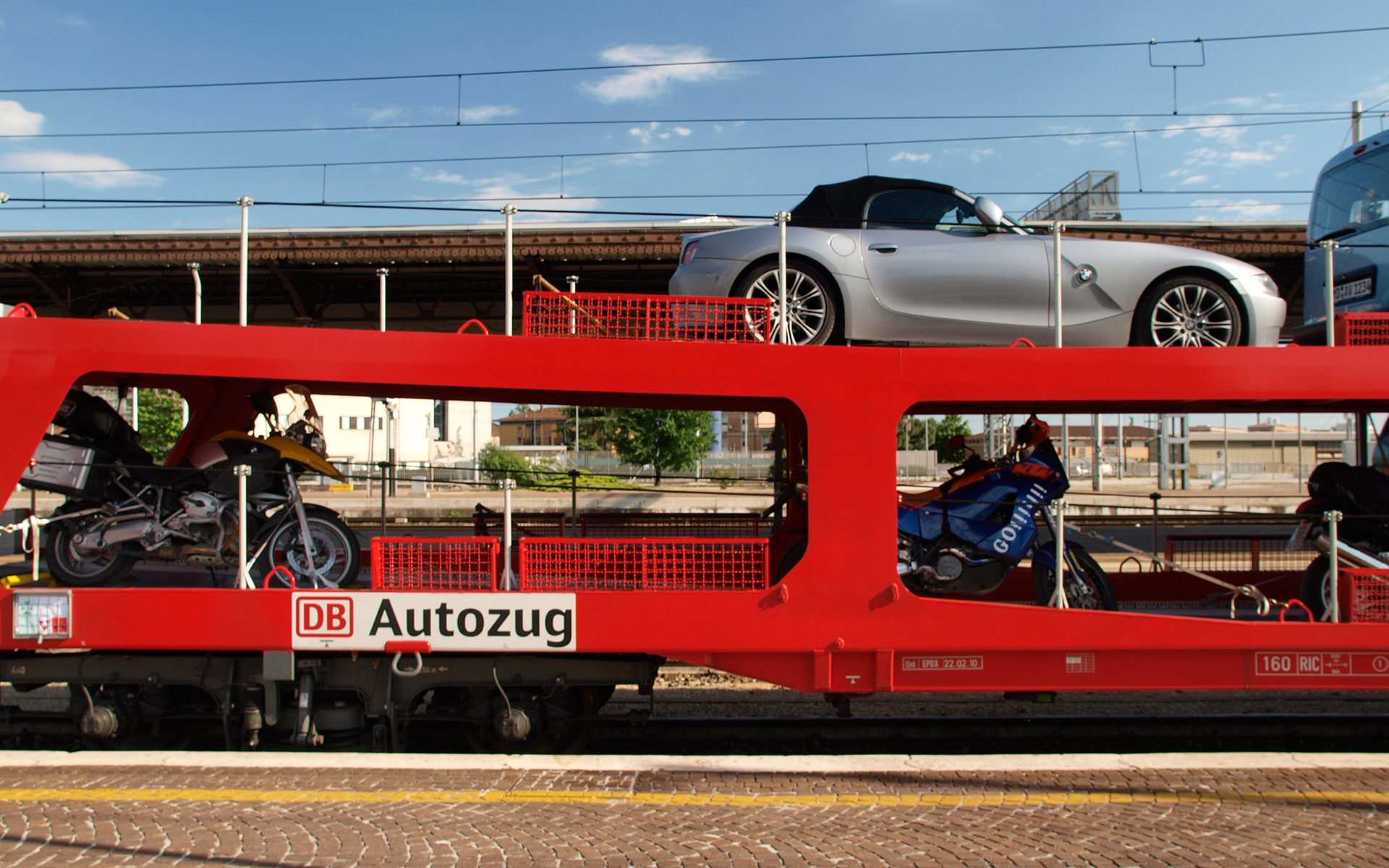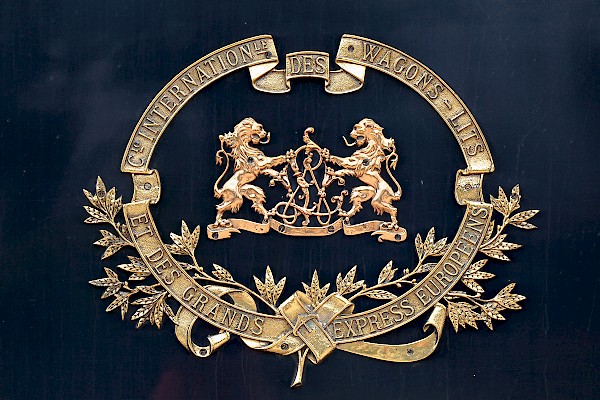Taking your car on the train 50 years ago
A DB Autozug car train (photo © hidden europe).
Here’s an idea from yesteryear which would be so good today. During the holiday season hundreds of families squeeze into their cars, full of holiday luggage, and leave Germany’s Rhine-Ruhr region to dash south on the autobahn to Bavaria or the Austrian Tyrol for summer vacation. Would it not be so much better if dozens of cars could be loaded onto a car train so that parents and kids could cruise south in comfort during the day? Just think of the carbon emissions saved.
A half century ago, there was just such a train. It was called the Christoforus Express. In 1973, it ran daily throughout the year. For many Germans of that period this daytime car train, and others like it, signalled the start of the holidays.
In July 1973, the Christoforus Express left the car-train terminal in Düsseldorf at 06.55 and Köln-Deutz at 07.31. Arrival in Munich was at 13.55. Before long, families were on their way in their own cars, hitting the open road and with just an hour or two of driving to reach their first camp site or hotel.
An era of growing car ownership
Fewer carbon emissions, less frazzled parents and for kids the real excitement of seeing the family car loaded on a train which carried both humans and vehicles.
In the early 1970s, personal car ownership boomed and a new generation of motorists was keen to have car-based holidays. But in those days Europe didn’t have a comprehensive network of motorways so some journeys by car were unpredictable and slow. Germany, with its excellent autobahns, was better than most, but even here the daytime car train like the Christoforus Express made perfect sense.
Some of those new motorists in the 1960s and 1970s did not want to entirely forsake the train. So across Europe, there was a blossoming network of car trains. Most of these were long-distance services which ran overnight. But there were many interesting daytime trains geared at motorists who would prefer to load their vehicle onto a train and not have to tussle with the traffic.
This article is about those daytime car trains. We look here at a selection of services which were operating 50 years ago this month, so in July 1973.
South to Lyon
The stretch of the Autoroute du Soleil from Paris to Lyon was already well used by 1973. Too well used for some drivers who opted instead to take the morning train from Paris to Lyon. The 09.05 train from the Gare de Lyon in Paris had carriages bound for Grenoble, Marseille and Toulouse, the latter routing via the Rhône Valley and the coast and not reaching Toulouse until 20.30 in the evening. But that 09.05 departure from Paris also transported cars as far as Lyon. Motorists wanting to use the service had to drop their cars off by eight in the morning. They could then board the train. Motorists were reunited with their vehicles at Lyon Perrache by two in the afternoon.
Hamburg to Basel
The journey above involved cars being transported on a regular scheduled train. Many car trains in summer 1973 were dedicated services like the Christoforus Express. Another dedicated service in summer 1973 was the thrice-weekly daytime train for motorists from Hamburg and Hannover to Basel. This seasonal service, geared very much at families, complemented the overnight car train on the same route which ran all year. For the daytime train, cars were loaded in Hamburg around 06.30 and in Hannover around 08.30 with arrival in Basel at 17.10. The train carried a restaurant car with a choice of first or second class seating.
The Sylt shuttle
Another daily car train in summer 1973 was a popular service from West Berlin to the North Sea island of Sylt. That island is linked by a causeway to the mainland called the Hindenburgdamm; it carries a railway to Sylt. There were many West Berliners who loved summer holidays on Sylt but were a little nervous about driving through the territory of East Germany (the DDR). So the daily summer-season car train was a perfect solution. Cars were loaded at Wannsee around nine in the morning. The train departed at 10.38 for the seven-and-a-half hour journey to Sylt. The train conveyed a Mitropa dining car. How very civilised. If such a service existed today, we would be first in line to buy tickets for it.
There were many similar daytime car trains in different parts of Europe, many of them operating only in the summer months and sometimes only on one or two days each week. There were for example Friday trains for motorists from both Frankfurt and Stuttgart to Salzburg in Austria.
Brits to Switzerland
There was an interesting weekly service in summer 1973 geared fair and square at British holidaymakers heading for Switzerland. Travellers were booked on the Saturday evening ferry from Harwich to Hoek van Holland. This overnight crossing by ship was operated by the Zeeland Steamship Company. Arrival at the Hook was at 06.15 local time, where cars and passengers were transferred onto a waiting train for a daytime journey up the Rhine Valley to give a late afternoon arrival in Basel.
Seaside specials
In Italy, car trains ferried the summer crowds and their cars from Milan down to the beach resort of Viareggio on the Tuscan coast. In England, the huge popularity of Devon and Cornwall in the early 1970s stimulated lots of demand for summer-season car trains to south-west England. The car train terminal at Kensington Olympia in London was busy on some mornings with car trains leaving for Newton Abbot, Totnes and St Austell.
Part of the appeal of these routes to Devon and Cornwall was the prospect of bypassing the legendary summer traffic jams on the main highways (the A30 and the A303) to south-west England in this era before the opening of motorways to the region.
To Wales, Scotland and Ireland
For four summer months in 1973, there was also a departure each morning from Kensington Oylmpia for Carlisle which, after dropping passengers and vehicles there, then continued to Perth in Scotland. There was another car-train terminal in London at Paddington station from where summer trains ran to south Wales with one service running on to Fishguard Harbour where cars and passengers could transfer onto the ferry to Ireland. A feature of all the daytime services mentioned in this paragraph was that the trains all offered only first-class seating and there was a restaurant car. Motorists taking their cars on holiday on these daytime trains were clearly pampered.
Over the years, a lot has been written about how overnight car trains were, in the closing decades of the last century, a key part of Europe’s transport infrastructure. Some of those long-haul services still exist today. But the seasonal daytime trains of the 1970s, which carried cars and their passengers, are a largely forgotten element of railway history.






About The Authors
Nicky Gardner and Susanne Kries
Nicky and Susanne manage hidden europe, a Berlin-based editorial bureau that supplies text and images to media across Europe. From 2005 to 2023, they were the editors of hidden europe magazine. Nicky and Susanne are dedicated slow travellers and the authors of the book Europe by Rail: The Definitive Guide. The 18th edition of that book was published in October 2024. You'll find a list of outlets that sell the book on this website. Susanne and Nicky also provide consultancy to the rail industry on fares, routes and ticketing. Between them, they know a thing or two about rail APIs.